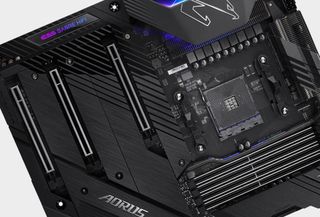A faster PCI Express 6.0 specification is on track for 2021
Actual motherboards adopting the spec could come way later, though.

The Peripheral Component Interconnect Special Interest Group (PCI-SIG), the standards body overseeing the development of the PCI Express bus specification, has fast-tracked an early revision of the PCIe 6.0 specification introduced three months ago. PCI-SIG member companies can now review and offer input toward a final spec that is slated to arrive in 2021.
PCI Express is an important part of the PC ecosystem. Each new generation increases the bandwidth, and in turn paves the way for faster communication with critical components like the graphics card, solid state drives, and other peripherals. PCIe 6.0 doubles the data rate over PCIe 5.0, which was only recently ratified and has yet to be adopted by any consumer motherboards.
Therein lies a point of frustration, to some extent—newer PCIe standards are slow to find their way into shipping products. For example, the PCIe 4.0 spec was finalized in 2017, but AMD's X570 chipset for third-gen Ryzen was the first consumer chipset to finally support it, and the RX 5700 series GPUs are currently the only graphics cards to support it.
The good news is that the PCIe bus is not much of a bottleneck for today's hardware, as it relates to real world performance gains. This is especially true for GPUs. Storage is a more immediate beneficiary, as PCIe 4.0 SSDs push sequential read performance into 5,000MB/s territory (the previous PCIe 3.0 SSDs topped out at around 3,500MB/s, due to the bandwidth limits of an x4 PCIe link). Of course, the added speed is of little benefit for gaming compared to even a SATA-based SSD (you can verify a game install in Steam much quicker, though).
As for the theoretical bandwidth each spec offers, here's a rundown:
- PCIe 6.0 (2021): 64.0 GT/s transfer rate, ~256GB/s x16 bandwidth
- PCIe 5.0 (2019): 32.0 GT/s transfer rate, ~128GB/s x16 bandwidth
- PCIe 4.0 (2017): 16.0 GT/s transfer rate, ~64GB/s x16 bandwidth
- PCIe 3.0 (2010): 8.0GT/s transfer rate, ~32GB/s x16 bandwidth
- PCIe 2.0 (2007): 5.0GT/s transfer rate, ~16GB/s x16 bandwidth
- PCIe 1.0 (2003): 2.5GT/s transfer rate, ~8GB/s x16 bandwidth
Note that the GT/s rate is per lane, in each direction. So PCIe 6.0 at 64 GT/s means each lane can do ~8GB/s up and down. That's the same performance in a single lane as PCIe 2.0 provided over an x16 link. Or if you prefer, 128GB/s in each direction for an x16 link will be possible.
The doubling of the data rate (while maintaining backward compatibility) is only part of the upgrade, however.
The biggest gaming news, reviews and hardware deals
Keep up to date with the most important stories and the best deals, as picked by the PC Gamer team.
"Two of the key changes that we're implementing include PAM-4 (Pulse Amplitude Modulation with 4 levels) encoding and low-latency Forward Error Correction (FEC) with additional mechanisms to improve bandwidth efficiency," Al Yanes, PCI-Sig board chair and president stated in a blog post.
Our friends at AnandTech posted a technical breakdown of those bits. As this all pertains to our interests, it's going to be several years before PCIe 6.0 makes headway into the consumer sector—it could be 2022 or even later before motherboards supporting the spec actually show up.
The real need for faster interconnects comes in datacenter hardware. Right now, a 100Gb/s full duplex network connection requires an x16 PCIe 3.0 link. Once the hardware for PCIe 6.0 is in place, a server could use a single x2 link for the same bandwidth. Which means a server could potentially have eight such network adapters, or alternatively, a single 1Tb/s link.
Paul has been playing PC games and raking his knuckles on computer hardware since the Commodore 64. He does not have any tattoos, but thinks it would be cool to get one that reads LOAD"*",8,1. In his off time, he rides motorcycles and wrestles alligators (only one of those is true).
Most Popular






